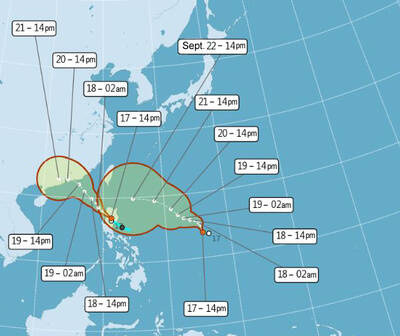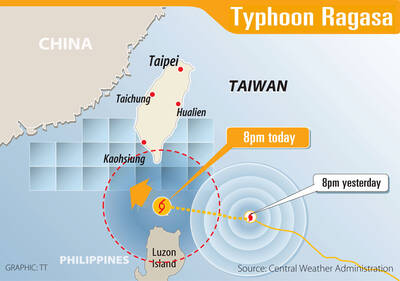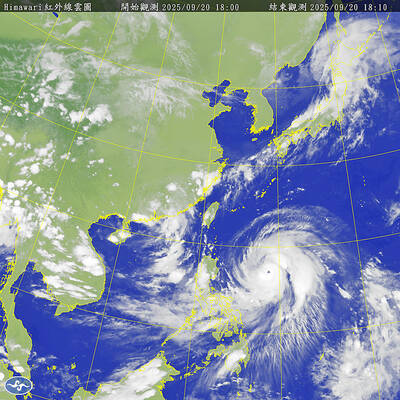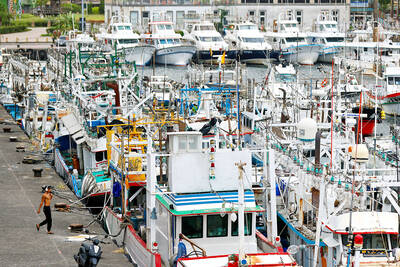The Greater Kaohsiung Environmental Protection Bureau yesterday said it has found another electroplating company in the city’s Jenwu District (仁武) that has been illegally discharging highly acidic wastewater containing more than 500 times the legally allowed amount of nickel into the Houjin River (後勁溪).
Bureau inspectors on Friday revealed that the Lian-yi Industrial Co (連益工業) has been using hidden pipes connected to the rain water sewer system to dump wastewater into the river, a discovery that was confirmed by bureau Director-General Derek Chen (陳金德) when he visited the company yesterday.
Advanced Semiconductor Engineering Inc (ASE, 日月光半導體) was caught dumping toxic water into the river last week.
“The wastewater had 518 milligrams of nickel per liter [mg/L], more than 500 times the 1 mg/L limit set by regulations, meaning that Lian-yi’s wastewater is even more toxic than ASE’s, which had 4.38mg/L,” Chen said.
Furthermore, Lian-yi’s wastewater had a pH level of 2.2 and contained up to 33.3mg/L of zinc, a concentration that also exceeds the standard of 5mg/L, the bureau said.
The bureau said that out of the 65 times that it has inspected the company since 2001, Lian-yi was found to have violated environmental regulations six times, three of which involved wastewater discharge, but the electroplating firm was only reprimanded and told to meet standards within a given period of time. This time, the bureau said it will fine the company for contravening the Water Pollution Control Act (水污染防治法) and order it to shut down.
Meanwhile, the Council of Agriculture said that testing on eight rice samples grown near the river showed that they all had acceptable levels of heavy metals.
The council’s Agriculture and Food Agency (AFA) said that the Farm Irrigation Association of Greater Kaohsiung closed the river’s irrigation water channel gate on Oct. 25, adding that the water is not used for irrigation during the winter.
AFA Deputy Director Huang Mei-hua (黃美華) said that his agency took five samples of rice grown in the area and sent to public granaries, as well as three samples of rice sold to private companies for the tests.
While the results showed that all the samples had safe levels of heavy metals, the agency said it will retest the quality of the river’s water for heavy metals before the first farming season begins next year to ensure that contaminated water will not be used for irrigation.
Regarding a report last week showing that irrigation water polluted by wastewater illegally discharged by eight electroplating companies in Changhua County, the agency said that of the 327 hectares of possibly affected farmland, 45.3 hectares were confirmed to contain excessive concentrations of heavy metals between April and September, while all the rice grown in the area has been destroyed.
The 1,410 tonnes of rice cultivated in the remaining 281.7 hectares in the second season that have already been sold are being traced and 11 samples have been sent for testing, it said.

One of two tropical depressions that formed off Taiwan yesterday morning could turn into a moderate typhoon by the weekend, the Central Weather Administration (CWA) said yesterday. Tropical Depression No. 21 formed at 8am about 1,850km off the southeast coast, CWA forecaster Lee Meng-hsuan (李孟軒) said. The weather system is expected to move northwest as it builds momentum, possibly intensifying this weekend into a typhoon, which would be called Mitag, Lee said. The radius of the storm is expected to reach almost 200km, she said. It is forecast to approach the southeast of Taiwan on Monday next week and pass through the Bashi Channel

WARNING: People in coastal areas need to beware of heavy swells and strong winds, and those in mountainous areas should brace for heavy rain, the CWA said The Central Weather Administration (CWA) yesterday issued sea and land warnings for Typhoon Ragasa, forecasting that it would continue to intensify and affect the nation the most today and tomorrow. People in Hualien and Taitung counties, and mountainous areas in Yilan and Pingtung counties, should brace for damage caused by extremely heavy rain brought by the typhoon’s outer rim, as it was upgraded to a super typhoon yesterday morning, the CWA said. As of 5:30pm yesterday, the storm’s center was about 630km southeast of Oluanpi (鵝鑾鼻), Taiwan’s southernmost tip, moving northwest at 21kph, and its maximum wind speed had reached

The Central Weather Administration (CWA) yesterday said that it expected to issue a sea warning for Typhoon Ragasa this morning and a land warning at night as it approached Taiwan. Ragasa intensified from a tropical storm into a typhoon at 8am yesterday, the CWA said, adding that at 2pm, it was about 1,110km east-southeast of Oluanpi (鵝鑾鼻), Taiwan’s southernmost tip. The typhoon was moving northwest at 13kph, with sustained winds of up to 119kph and gusts reaching 155kph, the CWA Web site showed. Forecaster Liu Pei-teng (劉沛滕) said that Ragasa was projected to strengthen as it neared the Bashi Channel, with its 200km

PUBLIC ANNOUNCEMENTS: Hualien and Taitung counties declared today a typhoon day, while schools and offices in parts of Kaohsiung and Pingtung counties are also to close Typhoon Ragasa was forecast to hit its peak strength and come closest to Taiwan from yesterday afternoon through today, the Central Weather Administration (CWA) said. Taiwan proper could be out of the typhoon’s radius by midday and the sea warning might be lifted tonight, it added. CWA senior weather specialist Wu Wan-hua (伍婉華) said that Ragasa’s radius had reached the Hengchun Peninsula by 11am yesterday and was expected to hit Taitung County and Kaohsiung by yesterday evening. Ragasa was forecast to move to Taiwan’s southern offshore areas last night and to its southwestern offshore areas early today, she added. As of 8pm last night,